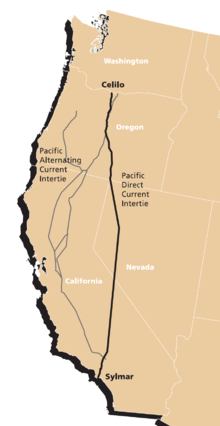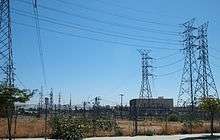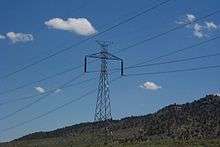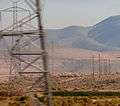Pacific DC Intertie

The Pacific DC Intertie (also called Path 65) is an electric power transmission line that transmits electricity from the Pacific Northwest to the Los Angeles area using high voltage direct current (HVDC). The line capacity is 3,100 megawatts, which is enough to serve two to three million Los Angeles households and represents almost half (48.7%) of the Los Angeles Department of Water and Power (LADWP) electrical system's peak capacity.[1]
The intertie originates near the Columbia River at the Celilo Converter Station of Bonneville Power Administration's grid outside The Dalles, Oregon and is connected to the Sylmar Converter Station north of Los Angeles, which is owned by five utility companies and managed by LADWP. The Intertie can transmit power in either direction, but power flows mostly from north to south.
The idea of sending hydroelectric power to Southern California had been proposed as early as the 1930s, but was opposed and scrapped. By 1961, US president John F. Kennedy authorized a large public works project, using new high voltage direct current technology from Sweden. The project was undertaken as a close collaboration between General Electric of the US and ASEA of Sweden. Private California power companies had opposed the project but their technical objections were rebutted by Uno Lamm of ASEA at an IEEE meeting in New York in 1963. When completed in 1970 the combined AC and DC transmission system was estimated to save consumers in Los Angeles approximately US $600,000 per day by use of cheaper electric power from dams on the Columbia River.
One advantage of direct current over AC is that DC current penetrates the entire conductor as opposed to AC current which only penetrates to the so-called skin depth. For the same conductor size the effective resistance is greater with AC than DC, so that more power is lost as heat. In general the total costs for HVDC are less than an AC line if the line length is over 500–600 miles and with advances in conversion technology this distance has been reduced considerably. A DC line is also ideal for connecting together two AC systems that are not synchronized with each other. HVDC lines can help stabilize a power grid against cascading blackouts, since power flow through the line is controllable.
The Pacific Intertie takes advantage of differing power demand patterns between the northwestern and southwestern US. During winter, the northern region operates electrical heating devices while the southern portion uses relatively little electricity. In summer, the north uses little electricity while the south reaches peak demand due to air conditioning usage. Any time the Intertie demand lessens, the excess is distributed elsewhere on the western power grid (states west of the Great Plains, including Colorado and New Mexico).[2]
Components
The Pacific Intertie consists of:[3]
- The Celilo Converter Station which converts three phase 60 Hz AC at 230 to 500 kV to ±500 kV DC (1000 kV pole-to-pole) at 45°35′39″N 121°6′51″W / 45.59417°N 121.11417°WCoordinates: 45°35′39″N 121°6′51″W / 45.59417°N 121.11417°W.
- The grounding system at Celilo consists of 1,067 cast iron anodes buried in a two-foot trench of petroleum coke, which behaves as an electrode, arranged in a ring of 3,255 m (2.02 mi) circumference at Rice Flats (near Rice, Oregon), which is 10.6 km (6.6 mi) SSE of Celilo. It is connected to the converter station by two aerial 644 mm2 ACSR (aluminum conductor, steel reinforced) conductors, which end at a "dead-end" tower situated at 45°29′51″N 121°03′53″W / 45.497586°N 121.064620°W.
- A 1,362-kilometre (846 mi) overhead transmission line consisting of two ACSR conductors each 1,171 mm2 in cross sectional area (1.6" radius).
- The Sylmar Converter Station (34°18′42″N 118°28′53″W / 34.31167°N 118.48139°W) which converts DC to 230 kV AC (a process also called inverting) and is phase-synchronized with the L.A. power grid.
- The Sylmar grounding system is a line of 24 silicon-iron alloy electrodes submerged in the Pacific Ocean at Will Rogers State Beach[4] suspended in concrete enclosures about one meter above the ocean floor. The grounding array, which is 48 km (30 mi) from the converter station and is connected by a pair of 644 mm2 ACSR conductors, which are in the sections north of Kenter Canyon Terminal Tower at 34°04′04.99″N 118°29′18.5″W / 34.0680528°N 118.488472°W installed instead of the ground conductors on the pylons. It runs from Kenter Canyon Terminal Tower, via DWP Receiving Station U (Tarzana; a former switching station), Receiving Station J (Northridge) and Receiving Station Rinaldi (also a former switching station) to Sylmar Converter Station. On the section between Receiving Stations J and Rinaldi, one of the two shielding conductors on each of two parallel-running 230 kV transmission lines is used as electrode line conductor.
- The two lines when combined have a capacity of 3.1 gigawatts (in bipolar mode).
History

The first phase of the scheme, completed in May 1970, used only mercury-arc valves in the converters.[5] The valves were series connected in three six-pulse valve bridges for each pole. The blocking voltage of the valves was 133 kV with a maximum current of 1,800 amperes, for a transmission rating of 1,440 MW with a symmetrical voltage of 400 kV with respect to earth. The line is the DC part of a system of four 500 kV lines that connect the Pacific Northwest with the Southwest; the AC part is Path 15. This is one of two HVDC lines serving Los Angeles, the other is the Path 27.
- In 1972, after the Sylmar earthquake, the Sylmar Converter Station had to be reconstructed due to extensive damage.
- In 1982, the power rating of the mercury arc valve rectifiers was raised by various improvements to 1,600 MW.
- In 1984, the transmission voltage was pushed to 500 kV and the transmission power was increased to 2,000 MW by adding one six-pulse thyristor valve group rated at 100 kV to each pole.
- In 1989, a further increase of the transmission power to 3,100 MW took place by installing a 1,100 MW parallel connected thyristor converter in Celilo and Sylmar, the so-called Pacific Intertie Expansion
- In 1993, one pole of the Pacific Intertie Expansion converter station at Sylmar was completely destroyed by fire.[6] The converter was replaced in 1994/5 by Siemens.[7]
- 2004, Sylmar East station situated at 34°18′42″N 118°28′53″W / 34.31167°N 118.48139°W was upgraded from 1,100 MW to 3,100 MW (rededicated as the Sylmar Converter Station in 2005). The controls and older converters, including the mercury arc valves, were completely replaced by a single pair of 3,100 MW 12-pulse converters built by ABB.[8] In parallel with this project, the six-pulse mercury arc valves at the Celilo Converter Station were replaced with Siemens light-triggered thyristors (MARP replacement).
Gallery
-
The HVDC power line in Los Angeles (shorter tower carrying two wires on the right). The power line crosses Interstate 5 near the interchange with Interstate 210 in Sylmar.
-

The Pacific DC Intertie along a service road paralleling Highway 395. Many of the towers of the Intertie are of this simple, slender design
-

The slender tower's base tapers down to a single point that is bolted to a concrete anchor
-

The slender tower is supported laterally by four guy-wires
-

The Pacific Intertie outside of Benton, California
-

Pacific DC Intertie towers (left side) near Fernley, Nevada. The first few towers are self-supported. The towers on the far side use guy-wires.
See also
References
- ↑ Sharon Bernstein and Amanda Covarrubias, Times Staff Writers (September 10, 2006). "Heat Wave Caught DWP Unprepared". L.A. Times online. Retrieved 2006-09-11.
- ↑ Prabha Kundur, Powertech Labs Inc. (October 3, 2003). "Power System Security in the New Industry Environment: Challenges and Solutions" (powerpoint). IEEE. p. 17. Retrieved 2006-09-11.
- ↑ "The Pacific Intertie Scheme". Bonneville Power Administration. 2000-11-03. Archived from the original on 2005-04-26. Retrieved 2009-08-20.
- ↑ "Review of The Infrastructural City, edited by Kazys Varnelis". Places Journal.
- ↑ Compendium of HVDC schemes, CIGRÉ Technical Brochure No. 003, 1987, pp57-62.
- ↑ Fire aspects of HVDC thyristor valves and valve halls, CIGRÉ Technical Brochure No. 136, February 1999.
- ↑ Christl, N., Faehnrich, W., Lips, P., Rasmussen, F., Sadek, K.,Thyristor Valve Replacement Of The Pacific Intertie Expansion Sylmar East 500 Kv Hvdc Converter Station, IEE Sixth International Conference on AC and DC Power Transmission(Conf. Publ. No. 423), 1996.
- ↑ ABB Rededicates Sylmar Converter Station, 24 March 2005.